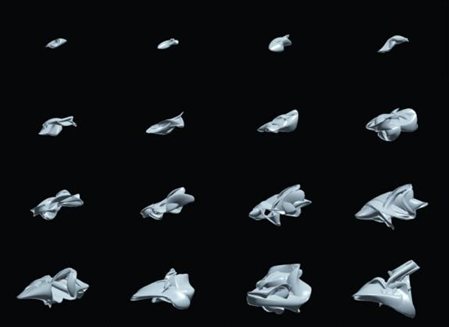Art, Complexity and Design
Description
Following the successful Exystence Symposium in Turin on Art, Complexity and Technology in May 2005, ECiD (the AHRB/EPSRC funded ‘Embracing Complexity in Design’ research cluster) will hold a workshop on Art, Complexity and Design on Friday 7 October 2005 to be held at University College London (UCL). This will offer the opportunity to see and discuss, from a design perspective, 2 of the Turin presentations on video. There will also be live presentations, a panel of artists discussing complexity & design from their perspective, and an exhibition of work by the artists.
If you missed the Turin Symposium then this is an excellent opportunity to join in this fascinating discussion. The workshop is free, you just need to contact Katerina Alexiou [a.alexiou@ucl.ac.uk] to book a place in advance, as space is limited.
Updated information, together with a map are on the ECiD website (note that the original website, http://www.complexityanddesign.net, is no longer active. Instead, please see the archived version.).
Documents
Interfacing with Evolution: towards a self organizing Architecture
Presenters
- John Hamilton Frazer — AA School of Architecture, London, UK
Description
Generative and evolutionary computing techniques are proposed to achieve the co-operative evolution of a sustainable future architecture.

The implication is a fundamental realignment of the roles of the user, the environment, the tool and means of construction. The computer becomes an evolutionary accelerator and the means of prediction and production; the user plays an active role in establishing the criteria for the validation of virtual prototypes for sustainable construction in the real world; the architect creates and sows new design concept seeds expressed in the genetic language of artificial form; and the environment is actively involved to effect the growth of the seeds so that each is unique to its situation.
This new model will be complete when design information is fully embedded in the intelligent and interactive substance of a built environment and is able to interface with the natural environment. Self-knowledge, self-assembly, self-modification and self-repair will finally lead to self-organization. The natural and artificial environments will merge, enabling the built environment to become integral to the very shaping of our planet’s future. This self-organizing process is known as autotectonics.
Based in the first instance on an analogy with the operation of natural biological processes, the model moves on to suggest a post-evolutionary strategy that transcends the analogy with nature and in turn becomes a means of interfacing to the evolutionary processes of nature. The autotectonic result may be a new form of designed artefact interacting and evolving with natural forces through pervasive computing and artificial intelligence.
Interactivator: Networked Evolutionary Design System
John Frazer, Julia Frazer, Manit Rastogi, Peter Graham, Patrick Janssen
Architectural Association, London, 1995
Documents
'Kovalevsky's top' and the Theatre of Complexity
Presenters
- Luc Steels — University of Brussels (VUB AI LAB) & Sony Computer Science Laboratory, Paris
Description
Luc Steels will report on a project with the French theatre director Jean-Francois Peyret to explore and communicate fundamental concepts of complex systems science through the medium of theatre. The piece will premier at the Avignon theatre festival, July 2005, and tour major theatre houses in Europe in the spring of 2006. The project is centred on the fascinating female Russian mathematician Sonya Kovalevsky who was at the centre of mathematical developments in dynamical systems towards the end of the 19th century, and who played a courageous pioneering role to give women access to scientific education and research. During this period, Weierstrass (Kovalevsky’s mentor) completed the arithmetisation of analysis, and new methods of integration were being discovered and applied to celestial mechanics and other physical systems. However the first cracks started to appear in the Laplacean dream that the world would be completely predictable once we know the equations describing it. Kovalevsky was an early contributor to these developments by her study of the ‘Kovalevky top’, which initiated the investigations in the integrability (and non-integrability) of non-linear systems.
Exploring the fundamental concepts of dynamics and complex systems in a theatrical medium is an enormous challenge. Our goal is not to make a ‘historical’ play but rather evoke fundamental ideas about the nature of mathematical and scientific imagination through dialogues, movement, and images. The main figure is Kovalevsky herself, but Poincare, Weierstrass, and Mittag-Leffler are present as additional ‘personages’.
Documents
Discussion
Presenters
- Moderator: Professor Eve Mitleton-Kelly
- Moderator: Professor Jeff Johnson
Description
Jeff Johnson and Eve Mitleton-Kelly will lead a discussion on the interaction of art, complexity and design, with an introduction by Jeff Johnson
Panel of Artists: Michael Petry, Mateo Willis, Julian Burton and Gail Troth will each discuss their approach to art, complexity and design and then open the session to discussion.
Exhibition of work: on art and complexity, by the artists above.